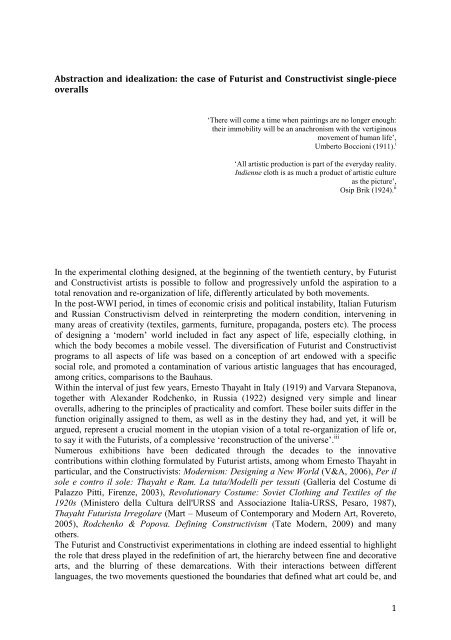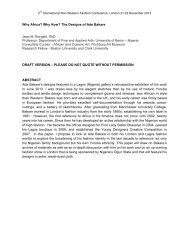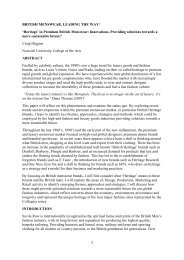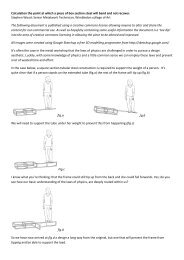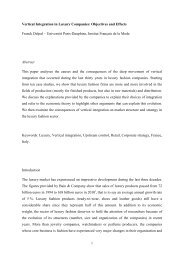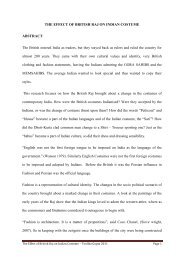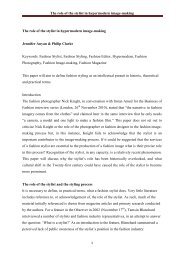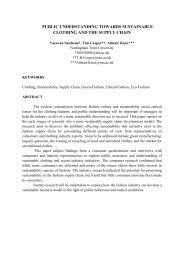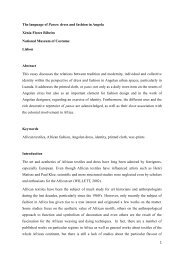1 Abstraction and idealization: the case of Futurist and ... - Arts
1 Abstraction and idealization: the case of Futurist and ... - Arts
1 Abstraction and idealization: the case of Futurist and ... - Arts
Create successful ePaper yourself
Turn your PDF publications into a flip-book with our unique Google optimized e-Paper software.
The Italian word „tutta‟, meaning „<strong>the</strong> whole, <strong>the</strong> entire‟, becomes in <strong>the</strong> brochure „tuta‟, for<strong>the</strong> missing consonant „t‟ can be found in <strong>the</strong> T-shape <strong>of</strong> <strong>the</strong> garment itself. The idea <strong>of</strong>totality, contained in <strong>the</strong> word „tutta‟, is unequivocally at <strong>the</strong> origin <strong>of</strong> <strong>the</strong> tuta that, in itsmaterialization, refers to <strong>the</strong> totality <strong>of</strong> <strong>the</strong> fabric <strong>and</strong> <strong>of</strong> <strong>the</strong> wearer; at <strong>the</strong> same time, <strong>the</strong> idea<strong>of</strong> collectivity (<strong>the</strong> totality <strong>of</strong> <strong>the</strong> people) is introduced, <strong>and</strong> in turn evokes <strong>the</strong> sameappearance <strong>of</strong> <strong>the</strong> people dressed in tuta. Unfolding <strong>the</strong> various layers <strong>of</strong> meaning, <strong>the</strong> three„t‟ in <strong>the</strong> word „tuta‟ could also hint at <strong>the</strong> concept <strong>of</strong> „trinity‟, while at <strong>the</strong> same time <strong>the</strong> techoes per se <strong>the</strong> Tau, a symbol for <strong>the</strong> absolute, <strong>the</strong> perfection <strong>of</strong> creation, <strong>the</strong> summary <strong>of</strong>everything in everything. The special attention given to <strong>the</strong> name is typical <strong>of</strong> ErnestoMichahelles who chose for himself a bifrontal palindrome as pseudonym. Thayaht, whostudied esoteric art <strong>and</strong> <strong>the</strong>osophy, found <strong>the</strong>n in <strong>the</strong> graphic expedient <strong>of</strong> <strong>the</strong> lost „T‟ <strong>the</strong>baptizing act <strong>of</strong> his sartorial invention.Since <strong>the</strong>n, <strong>the</strong> neologism „tuta‟ has permanently entered <strong>the</strong> Italian vocabulary, meaning agarment (ei<strong>the</strong>r overall or composed <strong>of</strong> a jacket <strong>and</strong> trousers) generally used to practicesports, or worn by workmen as mechanics, fabric workers, aviators, military <strong>of</strong>ficers etc.The tuta created by Thayaht was suitable for everyone <strong>and</strong> every occasion: it was a„universal‟ garment, xx extremely simple to realize, <strong>and</strong> particularly cheap. If 1 metre <strong>of</strong> cottonor hemp cloth was sold at <strong>the</strong> price <strong>of</strong> circa 7 liras, <strong>the</strong> confection <strong>of</strong> <strong>the</strong> tuta required in totalless than 50 liras, against <strong>the</strong> 100/150 liras usually necessary to buy an ordinary cottongarment. xxi It contemplated different variants <strong>of</strong> colour, but excluded any decorative element,featuring just 4 pockets, 7 buttons on <strong>the</strong> front, <strong>and</strong> a simple collar. It could be worn with abelt, <strong>and</strong> no shirt underneath, being originally a summer outfit. The photos <strong>of</strong> <strong>the</strong> time showThayaht with a walking stick, elegantly dressed in tuta, <strong>and</strong> wearing cutout Florentines<strong>and</strong>als, xxii which he invented, or T-bar „Forte dei Marmi‟ s<strong>and</strong>als. [Image 7] Indeed, <strong>the</strong> tutawas a garment tout court, for everyday life as well as for special occasions. That <strong>the</strong> tuta wasconceived for <strong>the</strong> masses is demonstrated by <strong>the</strong> specific choice <strong>of</strong> publication in «LaNazione», one <strong>of</strong> <strong>the</strong> first <strong>and</strong> most read newspapers <strong>of</strong> <strong>the</strong> times. Such a revolutionaryinvention, without being restricted to <strong>the</strong> elitarian world <strong>of</strong> haute couture, was destined toinfluence contemporary life, <strong>and</strong> <strong>the</strong>refore represents a significant step forwards in <strong>the</strong>direction <strong>of</strong> a democratization <strong>of</strong> fashion. Not by chance Thayaht is considered a precursor <strong>of</strong>numerous aspects <strong>of</strong> contemporary life <strong>and</strong> creativity. xxiiiIn Florence <strong>the</strong> tuta became very popular, <strong>and</strong> galas „in tuta‟ were regularly organized byFlorentine aristocratic families. In Rome <strong>and</strong> Milan, recalls historian Giovanna Uzzani,noblewomen, actresses <strong>and</strong> socialites, eager to adopt unusual looks, were among <strong>the</strong> first tobuy <strong>and</strong> order <strong>the</strong> tuta. xxiv Just few weeks after <strong>the</strong> publication <strong>of</strong> <strong>the</strong> first pattern by «LaNazione» more than one thous<strong>and</strong> <strong>of</strong> people adopted <strong>the</strong> tuta, which was appropriatelyconsidered <strong>the</strong> most provocative garment <strong>of</strong> <strong>the</strong> summer 1920. xxv The feminine version wasvery similar to <strong>the</strong> masculine one: it came in solid colour, had four pockets on <strong>the</strong> front, acollar <strong>and</strong> a belt almost identical to those <strong>of</strong> <strong>the</strong> male tuta. The only difference resided in <strong>the</strong>fact that it featured no trousers but was a sort <strong>of</strong> sack dress. The tuta for women representedin fact a fur<strong>the</strong>r simplification <strong>of</strong> <strong>the</strong> already very linear female clothing, <strong>and</strong> utilized nocostly materials. xxvi As vehemently argued by Thayaht <strong>and</strong> <strong>the</strong> o<strong>the</strong>r <strong>Futurist</strong>s, true elegancehas nothing to do with <strong>the</strong> quality <strong>of</strong> fabrics; hence women should abolish any vain <strong>and</strong> futileattention to exterior details, <strong>and</strong> ra<strong>the</strong>r concentrate on finding beauty in <strong>the</strong> absolutesimplicity. Thayaht even invites women to ab<strong>and</strong>on high heels, which are nothing else thanan anti-aes<strong>the</strong>tic <strong>and</strong> unhealthy fiction to increase height. xxvii Along <strong>the</strong> female <strong>and</strong> male tuta,in 1921 was created <strong>the</strong> bituta, that is, a tuta in two parts (a jacket <strong>and</strong> simplified trousers).This, says Thayaht, is even more practical than <strong>the</strong> tuta overall. Resulting from <strong>the</strong>experience generating <strong>the</strong> tuta, it represents in fact <strong>the</strong> perfected development <strong>of</strong> it. xxviiiIn <strong>the</strong> photographs <strong>of</strong> <strong>the</strong> time, Thayaht wears <strong>the</strong> bituta, appearing extremely elegant. xxix In4
<strong>the</strong> photos, <strong>the</strong> bituta‟s jacket is unstructured, light, <strong>and</strong> <strong>the</strong> look is generally unisex. Eventhough similar garments existed since <strong>the</strong> end <strong>of</strong> <strong>the</strong> XIX century, what Thayaht proposedwas an innovative translation in cut, mode <strong>of</strong> production, <strong>and</strong> modifications in use throughaddition <strong>of</strong> accessories (a simple belt, a hat), or hems in different colours, as for <strong>the</strong> femaletuta. The newness <strong>of</strong> Thayaht‟s sartorial experiment is manifest in comparison to <strong>the</strong> stiffformality <strong>of</strong> <strong>the</strong> contemporaneous menswear. The tuta reinterpreted in fact gender <strong>and</strong>masculinity in dress, opening up unexplored possibilities. In his creation, a prominenthygienic component is apparent: men <strong>and</strong> women wearing <strong>the</strong> tuta – <strong>the</strong> „tutisti‟ <strong>and</strong> „tutiste‟– are to be pioneers <strong>of</strong> hygiene <strong>and</strong> art. The same ideals <strong>of</strong> practicality <strong>and</strong> economy (<strong>of</strong>material, workmanship, time, energy), as well as <strong>the</strong> simple geometry <strong>of</strong> <strong>the</strong> model, seem tobe shared by <strong>the</strong> prododezhda designed few years later by Constructivist artists.Never<strong>the</strong>less, if this is conceived on <strong>the</strong> basis <strong>of</strong> a proletarian ideology, for which workconstitutes <strong>the</strong> mode par excellance <strong>of</strong> living <strong>and</strong> being part <strong>of</strong> society, <strong>the</strong> overall byThayaht needs to be contextualized within <strong>the</strong> <strong>Futurist</strong>s proposals <strong>of</strong> renovating every aspect<strong>of</strong> modern life. The tuta responds indeed to those formulations, expressed in <strong>the</strong> severalmanifestoes, according to which fashion should promote practicality, action <strong>and</strong> dynamism.At <strong>the</strong> same time, its manifest simplicity seems to distance it from <strong>the</strong> principles that are at<strong>the</strong> basis <strong>of</strong> <strong>the</strong> eccentric <strong>Futurist</strong>s clothing, <strong>and</strong> is ra<strong>the</strong>r close to <strong>the</strong> rationalization proposedby <strong>the</strong> Constructivists. In respect to <strong>the</strong> provoking experimentalism, in terms <strong>of</strong> shapes,materials <strong>and</strong> colours, promoted by <strong>the</strong> <strong>Futurist</strong> manifestoes, Thayaht develops an individualvoice that escapes rigid labels <strong>and</strong> could be ra<strong>the</strong>r considered an „unorthodox <strong>Futurist</strong>‟. xxx Hispeculiar versatility found expression in <strong>the</strong> fruitful collaboration with <strong>the</strong> Atelier Vionnet(1919-1924), for which he designed <strong>the</strong> logo, [Images 8 - 9] several models, <strong>and</strong> realizednumerous advertising illustrations published in <strong>the</strong> «Gazette du Bon Ton». In this sense,Thayaht is <strong>the</strong> only artist among <strong>the</strong> <strong>Futurist</strong>s to actively work within fashion, participating toits real productive processes, <strong>and</strong> represents a unique <strong>case</strong> <strong>of</strong> collaboration between ItalianFuturism <strong>and</strong> French haute couture. xxxiAt <strong>the</strong> time <strong>of</strong> its appearance, Thayaht‟s sartorial invention did not find an immediateindustrial response, despite <strong>the</strong> artist‟s intentions to obtain a patent for <strong>the</strong> diffusion <strong>of</strong> <strong>the</strong>tuta in Europe, USA, Canada <strong>and</strong> South Africa. In <strong>the</strong> later „Manifesto for <strong>the</strong>Transformation <strong>of</strong> Male Clothing‟ („Manifesto per la Trasformazione dell‟AbbigliamentoMaschile‟), written with RAM in 1932, Thayaht refers to <strong>the</strong> tuta as an example <strong>of</strong>innovation in clothing. xxxii Through <strong>the</strong> decades, <strong>the</strong> tuta in its innumerable variations hasfound ample diffusion in sportswear <strong>and</strong> work wear; it has deeply penetrated everyday life aswell as fashion, where it has been interpreted by different designers as Emilio Pucci, Krizia,Marucelli, Capucci, Ken Scott, just to name a few <strong>of</strong> <strong>the</strong>m.As a piece <strong>of</strong> clothing that would reflect, in its shapes, <strong>the</strong> dynamism <strong>and</strong> speed <strong>of</strong> <strong>the</strong>modern times, Thayaht‟s tuta abolished „obsolete‟ frills, <strong>and</strong> represented a „syn<strong>the</strong>tic‟ <strong>and</strong>„hygienic‟ solution in a climate <strong>of</strong> economic crisis. Among <strong>the</strong> various <strong>Futurist</strong> creations, <strong>the</strong>tuta is <strong>the</strong> only one that has entered any level <strong>of</strong> society, constituting <strong>the</strong> most modern <strong>and</strong>lasting <strong>of</strong> <strong>the</strong>m all, entering de facto ordinary language too. If a whole „reconstruction <strong>of</strong> <strong>the</strong>universe‟ was not practicable, at least some forward-looking instances <strong>of</strong> Futurism‟smodernizing attitude, as <strong>the</strong> tuta, have transformed daily life, reaching that universalityoriginally auspicated for <strong>the</strong>m.The urgency <strong>of</strong> a general re-organization <strong>of</strong> everyday life was expressed almost in <strong>the</strong> sameyears by Constructivist artists, who worked to realize <strong>the</strong>ir utopian project <strong>of</strong> a fulltransference <strong>of</strong> art into industrial production.In <strong>the</strong> post-revolutionary Russia, applied arts became indeed <strong>the</strong> instrument to materialize <strong>the</strong>Soviet utopian ideals. Artists gave a programmatic formulation to <strong>the</strong>ir desire to „reconstructnot only objects, but also <strong>the</strong> whole domestic way <strong>of</strong> life…both in its static <strong>and</strong> kinetic5
forms‟. xxxiii Extremely simple geometric shapes, <strong>and</strong> complementary colours, soon became<strong>the</strong> trademark <strong>of</strong> <strong>the</strong> practical, hygienic clo<strong>the</strong>s, designed by Constructivists artists, whichhad to suit <strong>the</strong> structures <strong>of</strong> <strong>the</strong> working life.As a post-WWI development <strong>of</strong> Russian Futurism, Constructivism developed in 1920-1922from a series <strong>of</strong> debates at INHUK, <strong>the</strong> Institute <strong>of</strong> Artistic Culture in Moscow (1920-1924),which culminated in <strong>the</strong> formulation <strong>of</strong> Productivist <strong>the</strong>ory, propounded in particular by OsipBrik. The manifesto <strong>of</strong> Productivism dem<strong>and</strong>ed <strong>the</strong> end <strong>of</strong> <strong>the</strong> easel painting, <strong>and</strong> moregenerally <strong>of</strong> art for art‟s sake, in favor <strong>of</strong> an immediate integration <strong>of</strong> art, life <strong>and</strong> industrialproduction. In <strong>the</strong> article „From easel-painting to <strong>the</strong> printed fabric‟ for <strong>the</strong> journal LEF (LeftFront <strong>of</strong> <strong>the</strong> <strong>Arts</strong>), xxxiv Brik argued: „only those artists who have understood once <strong>and</strong> for allthat work associated with production is not just one art-form among o<strong>the</strong>rs but <strong>the</strong> onlypossible art-form, only <strong>the</strong>y are in a position to find a solution to <strong>the</strong> problems <strong>of</strong>contemporary art‟. xxxvThe artistic production is now conceived in terms <strong>of</strong> consciousness <strong>of</strong> <strong>the</strong> production processitself, <strong>and</strong> <strong>the</strong> vehement „V proizvodstvo!‟ becomes <strong>the</strong> revolutionary motto <strong>of</strong> <strong>the</strong> Russianavant-garde. xxxvi The organic relationship between art <strong>and</strong> industry, <strong>and</strong> <strong>the</strong> edification <strong>of</strong> lifein its material forms, writes Boris Arvatov, is <strong>the</strong> practical program <strong>of</strong> <strong>the</strong>Constructivists. xxxvii Born is <strong>the</strong>n <strong>the</strong> idea <strong>of</strong> an art aiming at <strong>the</strong> restatement <strong>of</strong> new forms <strong>of</strong>life <strong>and</strong> social behaviour, an art that is in close connection with production <strong>and</strong> could reflect<strong>the</strong> structures <strong>of</strong> ordinary life (in Russian „byt‟). This connection is based on <strong>the</strong> identitybetween <strong>the</strong> notion <strong>of</strong> „art‟ <strong>and</strong> that <strong>of</strong> „work‟, postulated by Productivism. xxxviii In <strong>the</strong> postrevolutionaryRussia, art progressively ceases to be an aes<strong>the</strong>tic category <strong>and</strong> is almostidentified with <strong>the</strong> process <strong>of</strong> production. It is <strong>the</strong> refusal <strong>of</strong> an art springing fromcontemplation <strong>and</strong> from those notions <strong>of</strong> „inspiration‟, „genius‟ <strong>and</strong> „creativity‟. The slogansoutlined by Alex<strong>and</strong>er Rodchenko in 1921 indeed sound: „CONSTRUCTION is <strong>the</strong>contemporary requirement for <strong>the</strong> ORGANIZATION <strong>and</strong> utilitarian use <strong>of</strong> material. ACONSTRUCTIVE LIFE IS THE ART OF THE FUTURE. ART which has not entered lifewill be numbered <strong>and</strong> h<strong>and</strong>ed over to <strong>the</strong> archaeological museum <strong>of</strong> ANTIQUITY‟. xxxixConstructivists sharply distinguish between an art that pursues a pure aes<strong>the</strong>tic research froman art that, on <strong>the</strong> contrary, actively participates in that process <strong>of</strong> social evolution <strong>and</strong>transformation inaugurated by <strong>the</strong> October Revolution. Artists as Alex<strong>and</strong>er Rodchenko <strong>and</strong>Varvara Stepanova (Varst), who had previously worked in <strong>the</strong> realm <strong>of</strong> figurative art as well,soon ab<strong>and</strong>oned <strong>the</strong> aes<strong>the</strong>tic „composition‟ to embrace instead <strong>the</strong> „construction‟ following<strong>the</strong> Productivist principles. The demarcation between art, life <strong>and</strong> production thus dissolvesinto <strong>the</strong> program <strong>of</strong> a radical renovation involving any aspect <strong>of</strong> daily life.Within <strong>the</strong> quest for an absolute change, clothing constitutes a fundamental symboliccomponent: <strong>the</strong> objective for <strong>the</strong> Constructivists is in fact to create „production clothing‟(prozodezhda) that is no longer vehicle <strong>of</strong> signs evoking social distinctions, but is ra<strong>the</strong>rpractical, light <strong>and</strong> comfortable. In <strong>the</strong> overalls conceptualized <strong>and</strong> designed by Stepanova,any reference to an individual‟s social role or aes<strong>the</strong>tic preferences is completely absent. In<strong>the</strong> article „Kostjum segodnjasnego dnja-prozodezhda‟ („Present Day Dress – ProductionClothing‟), xl Stepanova explains that <strong>the</strong> worker‟s overall is conceived for a specific socialaction, <strong>and</strong> is diversified depending on <strong>the</strong> mansion <strong>the</strong> worker is called to fulfill.The October Revolution, as remarked by Tat‟jana Strizhenova, contributed to eliminate socialdiscrepancies in <strong>the</strong> way people used to dress, being <strong>the</strong> only differences determined by: <strong>the</strong>pr<strong>of</strong>ession, <strong>the</strong> environment (urban or rural), <strong>the</strong> climatic conditions, <strong>the</strong> national <strong>and</strong> culturaltraditions <strong>of</strong> <strong>the</strong> various Soviet republics. xli Varvara Stepanova, Liubov Popova, Alex<strong>and</strong>erRodchenko <strong>and</strong> Vladimir Tatlin all design simple, hygienic <strong>and</strong> functional clo<strong>the</strong>s.Stepanova‟s programmatic article with its insistence on functionality, anonymity, simplicity,6
efficiency, <strong>and</strong> a precise social role for clo<strong>the</strong>s, is perhaps <strong>the</strong> most eloquent <strong>and</strong> radicalproposal. xliiThe functional role <strong>of</strong> clothing, its „utilitarian‟ status, is exhaustively explained by Stepanovain <strong>the</strong> article for LEF: abolished are decorative motifs, while <strong>the</strong> buttoning <strong>and</strong> stitchinggiving shape to <strong>the</strong> garment are to be exhibited; any detail responds to <strong>the</strong> specific needsdictated by <strong>the</strong> material realization <strong>and</strong> <strong>the</strong> pr<strong>of</strong>ession <strong>the</strong> garment is destined to. Hence itdoes not contemplate any arbitrary design solution, <strong>and</strong> has no independent value, with <strong>the</strong>exception <strong>of</strong> <strong>the</strong> social function it performs. In this sense, <strong>the</strong> prozodezhda, also called byStepanova „programmed clothing‟, is an immediate expression <strong>of</strong> <strong>the</strong> Constructivist tendencytowards rationalization <strong>and</strong> uniformity, in which <strong>the</strong> concept <strong>of</strong> clothing as „artistic work‟succumbs to <strong>the</strong> needs dictated by <strong>the</strong> organization <strong>of</strong> ordinary life. Among <strong>the</strong> differentvariants <strong>of</strong> production clothing conceived by Stepanova, a special place is reserved to <strong>the</strong>„specodezda‟, designed for a group <strong>of</strong> specific pr<strong>of</strong>essions such as surgeons, aviators,workers <strong>of</strong> factories producing acids, firemen, Arctic explorers. Finally, <strong>the</strong> „sportodezhda‟ isa version conceived especially for sports <strong>and</strong>, depending on <strong>the</strong> particular discipline <strong>and</strong> <strong>the</strong>team it has to represent, acquires characteristic details. xliiiA photo dated 1922 shows Rodchenko wearing a model <strong>of</strong> overall that can be assimilated to<strong>the</strong> prozodezhda developed by Stepanova, while in <strong>the</strong> background lay some <strong>of</strong> Rodchenko‟sdisassembled spatial constructions. xliv [Images 10 - 11] The single-piece overall, made <strong>of</strong>stiff wool <strong>and</strong> lea<strong>the</strong>r inserts, is defined by a rigorous geometry that relies on an absolutestylization <strong>of</strong> <strong>the</strong> human forms. In all <strong>the</strong> designs for production clothing, <strong>the</strong> form <strong>and</strong>structure are indeed extremely clear. The one worn by Rodchenko presents <strong>the</strong> artist as aworker, dressed in an everyday garment that would result familiar to <strong>the</strong> majority <strong>of</strong> <strong>the</strong>population <strong>and</strong> at <strong>the</strong> same time embodies <strong>the</strong> collective nature <strong>of</strong> Soviet society. And yet <strong>the</strong>model unequivocally suggests <strong>the</strong> forward-looking technological agenda <strong>of</strong> Modernism.Indeed, <strong>the</strong> geometric integrity <strong>of</strong> <strong>the</strong> working clo<strong>the</strong>s by Stepanova, Rodchenko <strong>and</strong> Popova,observes Margarita Tupitsyn, is just an instance <strong>of</strong> <strong>the</strong> broad Constructivist-Productivist aimat „geometrising everyday life <strong>and</strong> people‟s movements‟. xlv The straight line <strong>and</strong> <strong>the</strong>geometrical compositions acquire <strong>the</strong> utopian power to shape, in any sector, ordinary life aswell as <strong>the</strong> monumental style <strong>of</strong> <strong>the</strong> Russian Soviet Federative Socialist Republic.As a consequence <strong>of</strong> this rationalization <strong>of</strong> clothing, <strong>the</strong> sexual difference seems to becomeirrelevant, or seems even suppressed. A peculiar „neutrality‟ characterizes not only workwear but also <strong>the</strong> <strong>the</strong>atrical costumes designed by Stepanova <strong>and</strong> Popova, where <strong>the</strong> gender isonly indicated by <strong>the</strong> alternative „skirt or trousers‟. In this respect, Christina Kiaer hasargued: „Constructivism‟s egalitarianism may have stemmed as much from <strong>the</strong> way in whichit attempted to reconceptualise <strong>the</strong> relation between masculine <strong>and</strong> feminine areas <strong>of</strong>experience, as from <strong>the</strong> way in which attempted to neutralize – or neuter – <strong>the</strong> differencesbetween <strong>the</strong>m‟. xlvi In discussing new clo<strong>the</strong>s, furniture design, <strong>and</strong> in particular his creationsfor <strong>the</strong> play Inga, Rodchenko admits <strong>the</strong> difficulty represented by <strong>the</strong> rationalization <strong>of</strong> <strong>the</strong>female suit, a question that can be posed only <strong>the</strong>oretically, „because its solution is anextremely difficult assignment‟. He adds <strong>the</strong>n: „This question needs work <strong>and</strong> more work,connecting <strong>the</strong> artist‟s search with everyday conditions‟. xlviiDespite being designed for <strong>the</strong> reality <strong>of</strong> ordinary life in <strong>the</strong> socialist society, <strong>the</strong>Constructivist overall, <strong>the</strong> prododezhda, remained an experimental design, <strong>and</strong> was never putinto production, being exclusively adopted by <strong>the</strong> avant-garde that created it. Given <strong>the</strong>impossibility to count on mass-production, many Constructivist designs were in fact mainlyspread through periodicals, posters <strong>and</strong> photomontages. Consequently, o<strong>the</strong>r Soviet designsfollowed <strong>the</strong> same destiny <strong>of</strong> <strong>the</strong> prododezhda, due to <strong>the</strong> lack <strong>of</strong> resources in <strong>the</strong> difficulteconomic circumstances <strong>of</strong> <strong>the</strong> post-revolutionary period. xlviii7
myth <strong>of</strong> a regenerating union <strong>of</strong> man <strong>and</strong> machine constitutes <strong>the</strong> supporting framework <strong>of</strong><strong>the</strong> fiction <strong>of</strong> power‟. lvi For <strong>the</strong> leader <strong>of</strong> Futurism, <strong>the</strong> automation <strong>of</strong> production possesses<strong>the</strong> potential to free culture from <strong>the</strong> burdens <strong>of</strong> <strong>the</strong> old humanism <strong>and</strong> its cult <strong>of</strong> reflectivedistance <strong>and</strong> interiority. lvii .It is clear that <strong>the</strong> divergences between <strong>the</strong> two movements are numerous, <strong>and</strong> yet ininterpreting <strong>the</strong> modern condition in <strong>the</strong> post-war years, <strong>the</strong>y both emphasized <strong>the</strong> social role<strong>of</strong> art <strong>and</strong> <strong>the</strong> relevance <strong>of</strong> industrial production. The transformation <strong>of</strong> society auspicated byartists from both groups ponders on clothing as a fundamental component <strong>of</strong> life, <strong>and</strong> takes<strong>the</strong> form <strong>of</strong> experiments that in some <strong>case</strong>s, as that <strong>of</strong> <strong>the</strong> tuta, enter <strong>the</strong> reality <strong>of</strong> lifepromoting a concrete democratization <strong>of</strong> fashion. In this sense, Thayaht‟s sartorial inventionrepresents an exception, being in fact absolutely accessible in respect to <strong>the</strong> vibranteccentricity <strong>of</strong> <strong>the</strong> <strong>Futurist</strong> designs. Thayaht‟s <strong>and</strong> <strong>the</strong> Constructivists‟ proposals constituteindeed a crucial instance <strong>of</strong> that shared aspiration to design a new world, finding also a mode<strong>of</strong> clothing for <strong>the</strong> new era. Interesting is that <strong>the</strong> spectacular valence that clothing holdswithin <strong>the</strong> <strong>Futurist</strong> programs is completely reversed in <strong>the</strong> Constructivist perspective, where<strong>the</strong> spectacle ra<strong>the</strong>r becomes <strong>the</strong> privileged testing ground for <strong>the</strong> less spectacular reality <strong>of</strong>daily life.Dr Flavia LoscialpoWith Special thanks to Riccardo Ernesto Michahelles <strong>and</strong> Caterina Chiarelli(Galleria del Costume, Palazzo Pitti).ImagesImage 1:9
Thayaht wearing <strong>the</strong> tuta, 1920.Image 2:10
Newspaper «La Nazione», 1920, „Taglio della tuta - Avvertenze‟ (The cut <strong>of</strong> <strong>the</strong> tuta -Indications).Image 3:Thayaht, How to cut <strong>the</strong> Tuta, 1920, explanatory drawing.Image 4:11
RAM, Tuttintuta, postal card, 1920.Image 5:12
Thayaht, flyer advertising <strong>the</strong> tuta, with <strong>the</strong> original lyrics for <strong>the</strong> carol „Tutti con la tuta‟(Everybody with <strong>the</strong> tuta), 1920.Image 6:RAM, Modella nell‟atelier, 1919 circa, a metaphysical painting <strong>of</strong> <strong>the</strong> time. by Courtesy <strong>of</strong>Riccardo Ernesto Michahelles, Florence (Italy).Thayaht wearing <strong>the</strong> tuta <strong>and</strong> „Forte dei Marmi‟ s<strong>and</strong>als.13
Image 7:Study featuring six proposals for <strong>the</strong> logo <strong>of</strong> Madeleine Vionnet. Signed „.Tayat.‟, without<strong>the</strong> „h‟, 1919. Pencil <strong>and</strong> gouache on paper, 180 mm x 250 mm. Courtesy <strong>of</strong> RiccardoErnesto Michahelles, Florence (Italy).Image 8:Postal cards created for <strong>the</strong> atelier <strong>of</strong> Madeleine Vionnet (1919-1922). Courtesy <strong>of</strong> RiccardoErnesto Michahelles, Florence (Italy).14
Image 8:Alex<strong>and</strong>er Rodchenko, single-piece overall, 1922 circa.15
Image 9:Alex<strong>and</strong>er Rodchenko wearing production clothing realized by Varvara Stepanova, 1922circa.Image 10:Varvara Stepanova, costumes for <strong>the</strong> play The death <strong>of</strong> Tarelkin by Sukhovo-Kobylin,Meierkhol‟d production, 1922.16
Selected bibliographyAdaskina, N.L., Liubov Popova, Harry N.Habrams, New York, 1990.Apollonio, U. (ed.), <strong>Futurist</strong> Manifestos, Tate Publishing, London, 2001.Arvatov, B., Kunst und Produktion, Carl Hanser Verlag, Munchen, 1972.Braun, E., „<strong>Futurist</strong> Fashion: Three Manifestoes‟, in Art Journal, 54, 1, 1995.Celant, G. <strong>and</strong> Maraniello, G. (eds.), Vertigo: A Century <strong>of</strong> Multimedia Art, From Futurismto <strong>the</strong> Web, Rizzoli, London, 2008.Celant, G., Sischy, I., Tabatabai Asbaghi, P. (eds.), Art/Fashion, Skira Editore, Milan 1977.Cerutti, C. <strong>and</strong> Sgubin, R., Futurismo, moda, design: la ricostruzione futurista dell‟universoquotidiano, Musei Provinciali di Gorizia, Gorizia, 2009.Chadwick, W., Women, Art <strong>and</strong> Society, Penguin, London, 1997.Chiarelli, C. (ed.), Per il sole e contro il sole. Thayaht e Ram. La tuta/Modelli per tessuti,Sillabe, Livorno, 2003.Conio, G., Le Constructivisme russe, vol.II, Âge d‟homme, Lausanne, 1987.Crispolti, E., Il futurismo e la moda. Balla e gli altri, Marsilio, Padova, 1986.Crispolti, E. , Il mito della macchina e altri temi del Futurismo, Celebes, Trapani 1969.De Maria, L. (ed.), Teoria e invenzione futurista, Mondadori, Milan, 1968.Degl‟Innocenti, D. (ed.), THAYAHT. Un artista alle origini del Made in Italy, Museo delTessuto Edizioni, Prato, 2007.Fonti, D., Thayaht <strong>Futurist</strong>a Irregolare, Skira, Milan, 2005.Garavalia, L.F. (ed.), Il futurismo e la moda, Excelsior, Milan, 2009.Gun<strong>the</strong>r, H. <strong>and</strong> Hielscher, K., Arte, produzione e rivoluzione proletaria, Guaraldi, Florence<strong>and</strong> Rimini, 1973.Gnoli, S., Un secolo di moda italiana: 1900-2000, Meltemi Editore, Roma, 2005.Kirke, B., Madeleine Vionnet, Chronicle Books, San Francisco 1998.Lavrentiev, A., Varvara Stepanova: The Complete Work, The MIT Press, Cambridge MA,1988.Lodder, C., Russian Constructivism, Yale University Press, New Haven <strong>and</strong> London, 1983.Maraini, A., Thayaht, Scultore, Pittore, Orafo, Edizioni Giannini, Firenze, 1932.17
Martin, R. (ed.), Cubism <strong>and</strong> Fashion, The Metropolitan Museum <strong>of</strong> Art, New York, 1998.Ottinger, D. (ed.), Futurism, Centre Georges Pompidou <strong>and</strong> 5 Continents Editions, Paris <strong>and</strong>Milan, 2008.Paolucci, A. <strong>and</strong> Laghi, A.V. (eds.), L‟estate incantata - Ram e Thayaht da Parigi a CasaBianca, Pacini Editore, Pisa, 2006.Pratesi, M. (ed.), Futurismo e Bon Ton - I fratelli Thayaht e RAM, Leo S. Olschki Editore,Firenze, 2005.Rodchenko, A., Experiments for <strong>the</strong> Future, edited by A.Lavrentiev <strong>and</strong> J.E.Bowlt, TheMuseum <strong>of</strong> Modern Art, New York, 2005.Sartini Blum, C., „The <strong>Futurist</strong> Re-Fashioning <strong>of</strong> <strong>the</strong> Universe‟, in South Central Review, 13,2/3, 1996.Schnapp, J.T., „The Fabric <strong>of</strong> Modern Times‟, in Critical Inquiry, 24, 1, 1997.Strizhenova, T., Moda e Rivoluzione, Electa, Milano, 1979.Tupitsyn, M., Rodchenko & Popova. Defining Constructivism, Tate Publishing, London,2009.Wunder, R.P., Hiram Powers: Vermont Sculptor, 1805-1873, Vol. 1: Life, <strong>and</strong> Vol.:Catalogue <strong>of</strong> Works The American Art Series, University <strong>of</strong> Delaware Press, Newark;Associated University Presses, London <strong>and</strong> Cranbury, NJ, 1989-1991.Yasinskaya, I., Soviet Textile Design <strong>of</strong> <strong>the</strong> Revolutionary Period, Thames <strong>and</strong> Hudson Ltd.,London, 1988.Zhadova, A., Tatlin, Rizzoli Int Publications, London, 1988.Zalambani, M., „L‟art dans la production. Le débat sur le productivisme en Russie pendantles années vingt‟, Annales. Histoire, Sciences Sociales, 52, 1, 1997.Zaletova, L., L‟abito della rivoluzione, Marsilio, Venezia, 1987.Zaletova, L., Ci<strong>of</strong>i degli Atti, F., Panzini, F. et al. (eds.), Revolutionary Costume. SovietClothing <strong>and</strong> Textiles <strong>of</strong> <strong>the</strong> 1920s, Rizzoli Publications, New York, 1989.Notesi U. Boccioni, „Note per la conferenza tenuta a Roma‟, in E.Coen, „There Will Come A TimeWhen Paintings Are No Longer Enough‟ in Vertigo: A Century <strong>of</strong> Multimedia Art, FromFuturism to <strong>the</strong> Web, edited by G. Celant <strong>and</strong> G. Maraniello, Rizzoli, London, 2008, p. 43ii O.Brik, „From Painting Canvas to Printing Cloth‟, Lef, 2, 6, 1924, pp.27-34, in L.Zaletova,F.Ci<strong>of</strong>i degli Atti, F.Panzini et al., Revolutionary Costume. Soviet Clothing <strong>and</strong> Textiles <strong>of</strong><strong>the</strong> 1920s, Rizzoli Publications, New York, 1989, p.175.18
iii „Ricostruzione futurista dell'universo‟, signed by Balla <strong>and</strong> Depero in 1915, reproduced inFuturismo, moda, design: la ricostruzione futurista dell‟universo quotidiano, edited byC.Cerutti <strong>and</strong> R.Sgubin, Musei Provinciali di Gorizia, Gorizia, 2009, p.237.iv In respect to this, it has been argued that early Futurism was „a reaction against <strong>the</strong> fin-desièclemalaise that took <strong>the</strong> form <strong>of</strong> a pervasive sense <strong>of</strong> a dislocation in <strong>the</strong> logical, causalrelationship between past, present, <strong>and</strong> future‟, C.Sartini Blum, „The <strong>Futurist</strong> Re-Fashioning<strong>of</strong> <strong>the</strong> Universe‟, in South Central Review, 13, 2/3, 1996, p.82.v E. Braun, „<strong>Futurist</strong> Fashion: Three Manifestoes‟, in Art Journal, 54, 1, 1995, p. 35.viU. Boccioni, C. Carra, L. Russolo, G. Balla, G. Severini, „Manifesto <strong>of</strong> <strong>the</strong> <strong>Futurist</strong>Painters‟, 1910, in <strong>Futurist</strong> Manifestos, edited by U. Apollonio, Tate Publishing, London,2001, p. 26vii E. Braun, ibid.viii W. Chadwick, Women, Art <strong>and</strong> Society, Penguin, London, 1997, p. 245.ix „Muscular colors‟ indicate very bright, even fluorescent, tonalities: „rossissimi, verdissimi,gialloni, aranciooooni, vermiglioni‟. In <strong>the</strong> introduction <strong>of</strong> <strong>the</strong> manifesto, dark colors areassociated with <strong>the</strong> mediocrity <strong>of</strong> bourgeois culture, while bright colors boast a new bellicosevitality. The notion <strong>of</strong> sartorial musculature is emphasized throughout both versions <strong>of</strong> <strong>the</strong>manifestoes, particularly in <strong>the</strong>ir discussion <strong>of</strong> color. J.T.Schnapp, „The Fabric <strong>of</strong> ModernTimes‟, in Critical Inquiry, 24, 1, 1997, p.199.x E.Braun, op.cit., p.35.xi In Italian, „Manifesto della moda femminile futurista‟, published on 29 February 1920 in<strong>the</strong> newspaper «Roma <strong>Futurist</strong>a». Reproduced in Futurismo, moda, design: la ricostruzionefuturista dell‟universo quotidiano, edited by C.Cerutti <strong>and</strong> R.Sgubin, Musei Provinciali diGorizia, Gorizia, 2009, p.236.xii Ibidem, <strong>the</strong> original reads „le conquiste piu affascinanti della vita moderna‟.xiii Ibidem, <strong>the</strong> original: „Glorificheremo la carne della donna in un frenesia di spirali etriangoli. Arriveremo a scolpire il corpo astrale della donna collo scalpello di una geometriaesasperata!‟.xiv In respect to gender difference, eloquent is <strong>the</strong> position <strong>of</strong> Marinetti as expressed in <strong>the</strong>later poem, written by in 1940, „Simultaneous Poetry <strong>of</strong> Italian Fashion‟, reproduced inItalian in Teoria e invenzione futurista, edited by L.De Maria, Mondadori, Milan, 1968,pp.1188-1189.xv See B.Kirke, Madeleine Vionnet, Chronicle Books, San Francisco, 1998.xvi For an accurate genealogy, <strong>and</strong> <strong>the</strong> complete works <strong>of</strong> Hiram Powers, see R.P.Wunder,Hiram Powers: Vermont Sculptor, 1805-1873, Vol. 1: Life, <strong>and</strong> Vol.: Catalogue <strong>of</strong> WorksThe American Art Series, University <strong>of</strong> Delaware Press, Newark; Associated UniversityPresses, London <strong>and</strong> Cranbury, NJ, 1989-1991.xvii Lecture „La Pittura <strong>Futurist</strong>a‟, given by Umberto Boccioni at <strong>the</strong> Associazione ArtisticaInternationale, Rome, May 1911, in Futurism, edited by D. Ottinger, Centre GeorgesPompidou <strong>and</strong> 5 Continents Editions, Paris <strong>and</strong> Milan, 2008, p. 55.xviii The adjective „syn<strong>the</strong>tic‟ refers in this <strong>case</strong> to <strong>the</strong> qualities <strong>of</strong> being comfortable, aes<strong>the</strong>tic<strong>and</strong> fresh, as explained by Ernesto Thayaht <strong>and</strong> Ruggero Michahelles in <strong>the</strong> „Manifesto for<strong>the</strong> Transformation <strong>of</strong> Male Clothing‟ („Manifesto per la trasformazione dell‟abbigliamentomaschile‟, 1932). Reproduced in Italian in E.Crispolti, Il futurismo e la moda. Balla e glialtri, Marsilio, Padova, 1986, p.137.xix Indicazioni per il taglio della “tuta” con e senza goletto – Avvertenze, published in «LaNazione», 19 June 1920.xx Ibidem.19
xxi E.Thayaht, La tuta nel 1921, manuscript, Archivio Seeber, Rome, quoted in Per il sole econtro il sole. Thayaht e Ram. La tuta/Modelli per tessuti, edited by C.Chiarelli, Sillabe,Livorno, 2003, p.12.xxii These lea<strong>the</strong>r s<strong>and</strong>als, with two holes on <strong>the</strong> front, reached extreme popularity in Italy,<strong>and</strong> have been adopted by several generations <strong>of</strong> children.xxiii See A.Maraini, Thayaht, Scultore, Pittore, Orafo, Edizioni Giannini, Firenze, 1932; <strong>and</strong>THAYAHT. Un artista alle origini del Made in Italy, edited by D. Degl‟Innocenti, Museo delTessuto Edizioni, Prato, 2007.xxiv G.Uzzani, essay „Per il sole e contro il sole‟, in <strong>the</strong> catalogue Per il sole e contro il sole.Thayaht e Ram. La tuta/Modelli per tessuti, edited by C.Chiarelli, Livorno, Sillabe, 2003,p.12.xxv Giovanna Uzzani recalls that <strong>the</strong> overnight popularity <strong>of</strong> <strong>the</strong> tuta caused a significant risein <strong>the</strong> price <strong>of</strong> cloth in Florence; <strong>the</strong> newspaper «La Nazione» threatened <strong>the</strong>n to renderpublic <strong>the</strong> names <strong>of</strong> those retailers that were speculating on <strong>the</strong> increasing dem<strong>and</strong> <strong>of</strong> <strong>the</strong>material, ibidem.xxvi In <strong>the</strong> same year, Marinetti encouraged women to ab<strong>and</strong>on any expensive habits in hismanifesto „Against Female Luxury‟. F.T.Marinetti, „Contro il lusso femminile‟, inE.Crispolti, op.cit., p.116; simultaneously, Lydia De Liguoro, director <strong>of</strong> <strong>the</strong> popularmagazine Lidel, at <strong>the</strong> Congress <strong>of</strong> Clothing Manufacturers <strong>and</strong> Retailers, in 1920, warnednot to buy imported luxury goods, promoting thus <strong>the</strong> Fascist ideals <strong>of</strong> saving in times <strong>of</strong>economic crisis while supporting Italian production, S.Gnoli, Un secolo di moda italiana:1900-2000, Meltemi Editore, Roma, 2005, p.46.xxvii Avvertimenti alle „tutiste‟, in «La Nazione», 2 July 1920, published in E.Crispolti, op.cit.,p.132.xxviii La „tuta‟ nel 1921, in «La Nazione», 7 July 1921.xxix Ernesto Thayaht was said to be very attentive in his way <strong>of</strong> dressing <strong>and</strong> appearing. See Ilfuturismo e la moda, edited by L.F.Garavalia, Excelsior, Milan, 2009, p.151: „la cura di unartista che ama farsi notare anche come persona‟.xxx Indeed, Thayaht <strong>Futurist</strong>a Irregolare („Thayhat Irregular <strong>Futurist</strong>‟) is <strong>the</strong> title <strong>of</strong> <strong>the</strong>exhibition dedicated to Thayaht‟s polyhedric activity by Mart – Museum <strong>of</strong> Contemporary<strong>and</strong> Modern Art, Rovereto, Italy, 2005. See also <strong>the</strong> catalogue Thayaht <strong>Futurist</strong>a Irregolare,edited by D.Fonti, Skira, Milan, 2005.xxxi During his intense collaboration with <strong>the</strong> Atelier Vionnet, Thayaht applied <strong>the</strong> principles<strong>of</strong> dynamic symmetry, which he studied by Jay Hambidge at Harvard University in 1920.Especially in <strong>the</strong> illustrations he produced, it is possible to appreciate <strong>the</strong> line forces creatinga peculiar dynamism within <strong>the</strong> image. Remarks Richard Martin: „as much as his line <strong>of</strong>forces suggest motion <strong>and</strong> eternity in <strong>the</strong> utopian forms <strong>of</strong> clothing that includedasymmetrical vests <strong>and</strong> jackets for men with <strong>Futurist</strong> prints, his 1920s illustrations forVionnet suggest at least an exalted ephemerality for fashion‟, Cubism <strong>and</strong> Fashion, edited byR.Martin, The Metropolitan Museum <strong>of</strong> Art, New York, 1998, p.129.xxxii In <strong>the</strong> same year <strong>the</strong> <strong>Futurist</strong> aeropainter Mino delle Site designed a <strong>the</strong>rmal tuta, made <strong>of</strong>physiological material <strong>and</strong> suitable for any season, allowing <strong>the</strong> body to brea<strong>the</strong> <strong>and</strong> keepingits temperature.xxxiii N.Tarabukin, Ot molberta k mashine, Rabotnik prosveshchenila, Moscow, 1923, pp.23-24, quoted in J.E.Bowlt, „Manufacturing dreams: textile design in revolutionary Russia‟, inL.Zaletova, F.Ci<strong>of</strong>i degli Atti, F.Panzini et al., Revolutionary Costume. Soviet Clothing <strong>and</strong>Textiles <strong>of</strong> <strong>the</strong> 1920s, Rizzoli Publications, New York, 1989, p.17.xxxiv LEF was launched, in 1923, by Vladimir Mayakovsky who edited it in collaboration withOsip Brik. Reflecting <strong>the</strong> concerns <strong>of</strong> Productivist ideology, it featured regular contributions20
y Alex<strong>and</strong>er Rodchenko, Varvara Stepanova, Sergein Eisentein, Boris Parsternak, DzigaVertov, Boris Arvatov, Alexei Gan, Liubov Popova etc. From 1927 to 1929 run as Novy LEF(New LEF), to finally be discontinued in 1929 following a dispute over its direction.xxxv Cited, in Italian, in Lidija Zaletova, L‟abito della rivoluzione, Marsilio, Venezia, 1987,pp.175-177.xxxvi „To production!‟ or, following <strong>the</strong> French translation, „A la production!‟, LEF, 1, 1923,pp.105-108; see G. Conio, Le Constructivisme russe, vol.II, Âge d‟homme, Lausanne, 1987,pp.43-44.xxxvii Iskusstvo i proizvodstvo, Proletkul‟t, Moscow, 1926, in B.Arvatov, Kunst undProduktion, Carl Hanser Verlag, Munchen, 1972; <strong>and</strong> in Arte, produzione e rivoluzioneproletaria, edited by H.Gun<strong>the</strong>r <strong>and</strong> K.Hielscher, Guaraldi, Florence <strong>and</strong> Rimini, 1973.xxxviii For an accurate reconstruction <strong>of</strong> <strong>the</strong> ideological debate that gave origin to <strong>the</strong> avantgarderecognizing itself in <strong>the</strong> slogan „art into production‟, see M.Zalambani, „L‟art dans laproduction. Le débat sur le productivisme en Russie pendant les années vingt‟, Annales.Histoire, Sciences Sociales, 1997, 52, 1, pp. 41-61. Taking departure from a closeexamination <strong>of</strong> <strong>the</strong> sources, <strong>the</strong> author demonstrates that <strong>the</strong> <strong>the</strong>oretical path leading toProductivism <strong>and</strong> Constructivism was not an easy one, <strong>and</strong> was ra<strong>the</strong>r strewn withdissensions <strong>and</strong> infighting.xxxix A.Rodchenko, Experiments for <strong>the</strong> Future, edited by A.Lavrentiev <strong>and</strong> J.E.Bowlt, TheMuseum <strong>of</strong> Modern Art, New York, 2005, p.142.xl LEF, 2, 1923, pp.65-68, entirely reproduced, with <strong>the</strong> title „Today‟s Fashion is <strong>the</strong>Worker‟s Overall‟, in L.Zaletova, F.Ci<strong>of</strong>i degli Atti, F.Panzini et al., Revolutionary Costume.Soviet Clothing <strong>and</strong> Textiles <strong>of</strong> <strong>the</strong> 1920s, Rizzoli Publications, New York, 1989, pp.173-174.The title cited in <strong>the</strong> text follows <strong>the</strong> translation proposed by Christina Lodder, RussianConstructivism, Yale University Press, New Haven <strong>and</strong> London, 1983, p.147.xli T.Strizhenova, Moda e Rivoluzione, Electa, Milano, 1979, pp.5-6.xlii At GINKhUK, <strong>the</strong> State Institute for Artistic Culture in Petrograd, Tatlin created models,in particular a workman‟s suit <strong>and</strong> coat, which allowed complete freedom <strong>of</strong> movement <strong>and</strong>responded to <strong>the</strong> new functions that clothing assumed in <strong>the</strong> Constructivist program.Never<strong>the</strong>less, <strong>the</strong>se designs were never industrially produced. The GINKhUK, as reported byTatlin, was concentrated in formulating „clothing norms‟ <strong>and</strong> in discovering „<strong>the</strong> properties <strong>of</strong>materials‟ to provide patterns for production, see V.Tatlin, „Report <strong>of</strong> <strong>the</strong> Section for materialCulture under <strong>the</strong> Museum <strong>of</strong> Artistic Culture to <strong>the</strong> Leningrad Division <strong>of</strong> <strong>the</strong> MainDirectorate <strong>of</strong> Scientific Institution‟, May 1924, in A.Zhadova, Tatlin, Rizzoli IntPublications, London, 1988, p.250xliiiV.Stepanova, „Kostjum segodnjasnego dnja-prozodezhda‟, Lef, 1923, 2, in L.Zaletova,F.Ci<strong>of</strong>i degli Atti, F.Panzini et al., op.cit., p.173.xliv The authorship <strong>of</strong> <strong>the</strong> prozodezhda worn by Rodchenko has been clouded by ambiguity, asChristina Lodder acutely points out. Some, as Strizhenova, imply that <strong>the</strong> prozodezhdafeaturing in <strong>the</strong> photo <strong>of</strong> 1922 was made by Rodchenko himself; never<strong>the</strong>less, <strong>the</strong> samephotograph is reproduced in <strong>the</strong> article O.Beskin „Otvet napravo – zapros nalevo‟, Sovetskoeiskusstvo, 1925, 6, p.8, with <strong>the</strong> apposite caption „V.Stepanova‟ – production clothing‟. SeeC.Lodder, op.cit., p.292, n.8. It is <strong>the</strong>n to be believed that Rodchenko designed that particularoverall, which was actually realized by Stepanova. While Rodchenko‟s overalls were neverproduced <strong>and</strong> ra<strong>the</strong>r remained prototypes, <strong>the</strong> artist was actively involved in making<strong>the</strong>atrical costumes, as those for <strong>the</strong> play Inga by Anatolii Glebov (1929).xlv M. Tupitsyn, „Being-in-production: The Constructivist code‟, in Rodchenko & Popova.Defining Constructivism, edited by M.Tupitsyn, Tate Publishing, London, 2009, p.25.21
xlvi C.Kiaer, „His <strong>and</strong> Her Constructivism‟, in Rodchenko & Popova. DefiningConstructivism, edited by Margarita Tupitsyn, Tate Publishing, London, 2009, p.145.xlvii A.Rodchenko, op.cit., p.199.xlviii Tat‟jana Strizhenova remarks that in 1917 serial production in dressmaking was barelyexistent, as 97% <strong>of</strong> <strong>the</strong> garments were still confectioned within an artisanal, almost feudal,environment; at <strong>the</strong> time, technological development was poor <strong>and</strong> <strong>the</strong> raw materials wereextremely scarce, T.Strizhenova, op.cit., p.5xlix Quoted in I.Yasinskaya, Soviet Textile Design <strong>of</strong> <strong>the</strong> Revolutionary Period, Thames <strong>and</strong>Hudson Ltd., London, 1988, p.11l Stepanova developed a methodology <strong>of</strong> working establishing that ‘pattern will best<strong>and</strong>ardized <strong>and</strong> will eventually be expressed in <strong>the</strong> processing <strong>of</strong> <strong>the</strong> fabric’s structure’,A.Lavrentiev, Varvara Stepanova: The Complete Work, The MIT Press, Cambridge MA,1988, p. 82.liJ.E.Bowlt, „Manufacturing dreams: textile design in revolutionary Russia‟, in L.Zaletova,F.Ci<strong>of</strong>i degli Atti, F.Panzini et al., op.cit., p.17.liiL.Popova, „Vstuplenie k diskussii INKhUKa o “Velikodushnom rogonostse”‟, 27 April1922, English translation in C.Lodder, op.cit., p.149liii C.Kiaer, op.cit., p.154.liv See „Who We Are. Manifesto <strong>of</strong> <strong>the</strong> Constructivist Group‟, in A.Rodchenko, op.cit.,pp.143-145.lv L.Popova, „Raboty 1920–21gg.‟ (December 1922), English translation in D.V.Sarabianov<strong>and</strong> N.L. Adaskina, Liubov Popova, Harry N.Habrams, New York, 1990, p.359.lvi C.Sartini Blum, op.cit, p.88lvii The futurist leader <strong>of</strong> <strong>the</strong> Italian Royal Academy even pairs <strong>the</strong> non-humanity <strong>of</strong> <strong>Futurist</strong>poems to <strong>the</strong> Productivist tendency <strong>of</strong> <strong>the</strong> Soviet avant-garde: „While <strong>the</strong> earth‟s poetscontinue more or less to spin nostalgias <strong>and</strong> despairs around <strong>the</strong> verses <strong>of</strong> Leopardi,Baudelaire or Mallarmé, <strong>the</strong> Italian <strong>Futurist</strong> Movement has for many years prompted its poets<strong>and</strong> artists to create a „non-human‟ poetry <strong>and</strong> art, which is to say a poetry <strong>and</strong> art extraneousto humanity thanks to its systematic extractions <strong>of</strong> new beauties <strong>and</strong> new music from <strong>the</strong>technicism <strong>of</strong> machine civiliation‟, „Invito ai lettori spregiudicati‟, preface to Marinetti‟s „IlPoema non umano dei tecnicisms‟ (Non-Human Poem <strong>of</strong> Technicisms), in F.T.Marinetti,Teoria e invenzione futurista, Mondadori, Milan, 1983, p.1142; originally published in 1937,in <strong>the</strong> manifesto „Poetry <strong>and</strong> Corporatist Art‟.22


